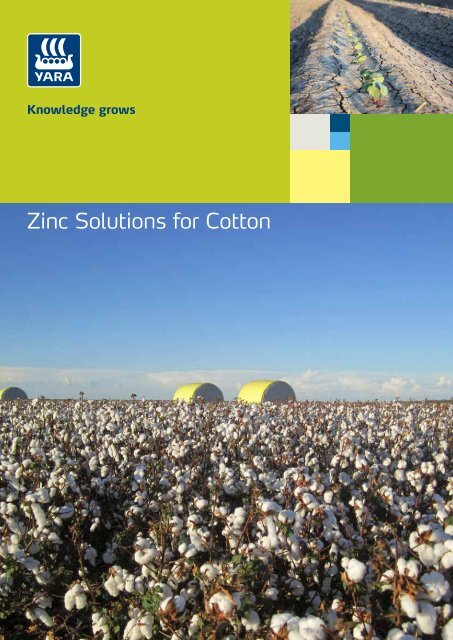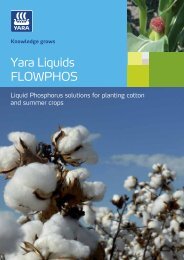Zinc Solutions for Cotton
2gdbyOb
2gdbyOb
Create successful ePaper yourself
Turn your PDF publications into a flip-book with our unique Google optimized e-Paper software.
<strong>Zinc</strong> <strong>Solutions</strong> <strong>for</strong> <strong>Cotton</strong>
<strong>Zinc</strong> <strong>Solutions</strong> <strong>for</strong> <strong>Cotton</strong><br />
<strong>Zinc</strong> (Zn) is essential <strong>for</strong> the normal<br />
growth and reproduction of cotton<br />
plants. <strong>Cotton</strong> is a moderately<br />
sensitive crop to zinc deficiency and<br />
when the supply of zinc to the plant is<br />
inadequate, crop yields are significantly<br />
reduced. <strong>Cotton</strong> is generally grown in<br />
heavy clay soils with high pH, elevated<br />
sodium and magnesium levels and low<br />
initial zinc levels. Although, much zinc<br />
has been applied to these fields, the<br />
availability of this zinc may be reduced<br />
due factors such as water logging and<br />
elemental tie-up.<br />
The Role of <strong>Zinc</strong> in the Plant<br />
<strong>Zinc</strong> plays a key role in a wide range of<br />
enzymes and proteins, controlling many<br />
important biochemical pathways. These<br />
are mainly concerned with;<br />
••<br />
Carbohydrate metabolism, both<br />
in photosynthesis and in the<br />
conversion of sugars to starch<br />
••<br />
Protein metabolism<br />
••<br />
Auxin (growth regulator) metabolism<br />
••<br />
Pollen <strong>for</strong>mation<br />
••<br />
Maintenance of the integrity of<br />
biological membranes<br />
••<br />
Resistance to infection by certain<br />
pathogens.<br />
Uptake, Movement & Removal<br />
of <strong>Zinc</strong><br />
High yielding irrigated cotton crops<br />
can take up about 260g Zn/ha. Of<br />
this, 150g Zn/ha (13g Zn/bale) may<br />
be removed in seed cotton and lint.<br />
As seen in Figure 1, 70% of the zinc is<br />
taken up during flowering. <strong>Zinc</strong> is able<br />
to move from leaves and stems to the<br />
lint, seed and boll walls with 60% being<br />
removed in the seed.<br />
<strong>Zinc</strong> is very immobile in the soil and<br />
needs to be either mixed through the<br />
root zone or sprayed onto the leaf to<br />
supply plant available zinc. This can be<br />
done through incorporation of surface<br />
applied zinc, in-furrow injection or a<br />
foliar spray.<br />
Figure 1.<br />
The pattern of nutrient uptake during the growth of an irrigated cotton crop<br />
that yielded 2250 kg lint/ha in Narrabri, Australia.<br />
Nutrient uptake (g/ha)<br />
2500<br />
2000<br />
1500<br />
1000<br />
500<br />
0<br />
40 60 80 100 120 140 160 180<br />
High Risk <strong>Zinc</strong> Deficient Situations<br />
High risk soils:<br />
••<br />
Calcareous<br />
••<br />
Salt affected<br />
••<br />
pH > 7<br />
••<br />
Fields that have been laser levelled<br />
••<br />
High phosphorus status or<br />
applications<br />
••<br />
Low organic matter and low zinc<br />
soil fertility<br />
Environmental conditions:<br />
••<br />
Waterlogged soils and crop<br />
••<br />
Cool, wet periods that reduce root<br />
growth<br />
••<br />
Crops affected by herbicides which<br />
reduce/ prune root growth<br />
DAS<br />
<strong>Zinc</strong> Deficiency Symptoms<br />
Figures 2, 3 and 4 illustrate zinc<br />
deficiency in cotton. The leaves can<br />
show yellowing between the leaf veins,<br />
leaves can appear bronzed and often<br />
are cupped. <strong>Zinc</strong> deficient plants are<br />
often shorter than unaffected plants,<br />
indicating that growth has been<br />
suppressed. Crops may grow out of<br />
zinc deficiency, especially when cotton<br />
is grown after long fallows, but yield,<br />
maturity and fibre quality may be<br />
affected.<br />
Figure 2. Cupping of <strong>Cotton</strong> leaf<br />
Figure 3. <strong>Cotton</strong> growth stunted from <strong>Zinc</strong> deficiency<br />
Figure 4.Leaf cupping and bronzing from <strong>Zinc</strong><br />
deficiency<br />
Fe<br />
Mn<br />
B<br />
Zn<br />
Cu<br />
© Yara
Critical <strong>Zinc</strong> Concentrations in<br />
the Soil and Plant<br />
The critical value <strong>for</strong> Soil DTPA<br />
Extraction (0-30 soil sample) is
Irrigated <strong>Cotton</strong> Crop Program<br />
Pre-Plant Planting Emergence<br />
1st Squares<br />
1st Squares<br />
1st Flowers<br />
1st Flower<br />
Peak Flower<br />
Peak Flower<br />
Bolls Open<br />
Approximate<br />
Day Degrees<br />
Yara Liquids<br />
Zn-SUL<br />
Apply<br />
20-60 L/ha and<br />
incorporate into<br />
soil<br />
70 - 540 540 - 840 840 -1300 1300 - 1600<br />
Yara Liquids<br />
FLOWPHOS 13Z<br />
Apply<br />
100-200L/ha<br />
Apply<br />
30-40 L/ha<br />
in-furrow<br />
Yara Liquids<br />
P-FOL <strong>Zinc</strong><br />
Apply a band spray 3-5 L/ha<br />
YaraVita <br />
ZINTRAC<br />
Apply 300mL-1 L/ha<br />
YaraVita <br />
GLYTREL ZnP<br />
Yara Liquids<br />
K-FLOW 0-14-30<br />
Yara Liquids<br />
K-FLOW 4-0-12<br />
Yara Liquids<br />
N26<br />
Yara Liquids<br />
N-FOL 24+TE<br />
Apply<br />
400-500L/ha<br />
in pre-irrigation<br />
Apply 2-3 L/ha as required with<br />
Glyphosate<br />
Apply 1-2 applications of 10 L/ha<br />
Apply 2-3 applications of<br />
30 L/ha, starting 7-10 days after<br />
first flower<br />
Apply 500-600 L/ha in multiple applications<br />
Apply 30-40 L/ha as required<br />
While Yara Australia has taken all reasonable care in the preparation of this document, the in<strong>for</strong>mation is a guide only. It is advised that potential users read the products Safety Data<br />
Sheet prior to using the product, which is available on request from Yara Australia. There are no warranties, express or implied by operation of law or otherwise, including but not limited to<br />
any warranty as to merchantability or fitness <strong>for</strong> any particular purpose.<br />
www<br />
1800 684 266 Yara_Australia au.sales@yara.com<br />
www.yara.com.au



